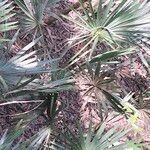A small palm. The trunk is underground. Some plants can have a trunk 1-2 m high. The trunk can be 25-30 cm across. The leaf stalk extends into the blade. The leaf stalk is strong and the leaves are held upright. The leaf blade may be split into 2 halves. The leaves are blue green. The flowering bunch is also upright but arches over and extends beyond the leaves. The flowers are small and white and have a scent. The fruit are about 1 cm across. They are black when ripe.









